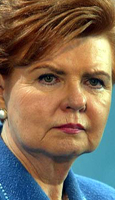    Etymology: The type is traditionally associated with the Baltic region of northern-northeastern Europe. Some confusion may arise from the fact that the term Baltid or Baltic is applied to a number of quite distinct types (or blends of types). This is the result of a general lack of synergy among scholars in the field.
- Osteuropid
(v. Eickstedt
and Deniker; subsumes
East-Baltid
and even Lappoid) Altered northeastern European
Cro-Magnoid type (ancestrally
related to the Dalo-Falid and
Brünn types of the northwest), reduced,
brachycephalized and
borealized through a selective
process of "balticization"
(not wholly dissimilar to
alpinization). The ancestral type ("East-Cro-Magnid")
is more obviously reflected in the less altered West-Baltid
end-type,
which we have here subsumed under the general Baltid definition, together with the
more "balticized" segment.
The stabilized Lappoid-influenced
periphery of the "Baltid continuum" is referred to as
East-Baltid, and to this end-type we have granted a separate
account (here). Baltids vary in stature, but are generally relatively tall, and moderately pyknomorphic in build. The head is moderately brachycephalic and rounded, with few visible cranial transitions. The forehead is high and broad, and only moderately curved, and the browridges tend towards heaviness in a typically Cro-Magnoid fashion. The face is moderately high, and the facial index is mesoprosopic, verging on eury- rather than leptoprosopy. The bizygomatic diameter is only moderately large, but large enough to render the impression, in concurrence with the great width and angularity of the jaw, of a characteristic facial squareness or rectangularity, a feature reminiscent of the Borreby type (there is a notable phenotypical overlap between these types). Oval or elliptical faces are, however, the most commonplace. The nose is moderately leptorrhine, and the root is moderately high to high, and of medium width. The nasal profile is usually straight, with a strong tendency towards concavity. The tip of the nose is typically well-rounded and slightly bulbous, and usually horizontally inclined. The alae are usually thin and highly placed, and of medium lateral extension. The lips are medium to thin, with little or no eversion. The teeth are large, the bite is frequently edge to edge, and orthognathy is almost universal. The eye-slits are medium to wide, and external eye-folds are rather common. Baltids are on the whole rather
light-pigmented. The hair, which is straight in form, ranges in color
from ash-blond to dark brown. Light eyes are quite common, but
dark-mixed varieties prevail. Celebrity examples (mostly generalized Baltids):
(Latvia) (Russia) (Russia) Geographical distribution: The Baltid population is most heavily concentrated in Estonia, Latvia and Lithuania, but extends both southwestward into former Prussia and northeastern Germany (partially in transition with the Borreby type), westward into Scandinavia (to a lesser extent), northward into Finland, and eastward into western Russia and the nearest adjacent political units. The transition with East-Baltid is principally to the north and northeast, but East-Baltids are as a rule quite common in all traditionally Baltid areas.
- Borreby |





